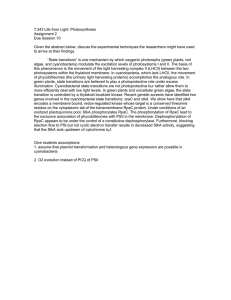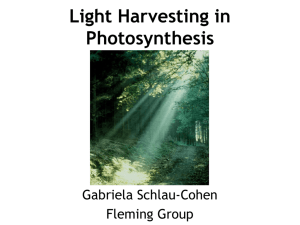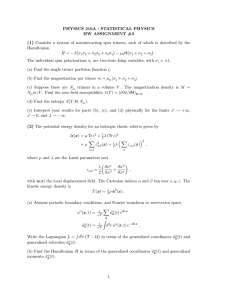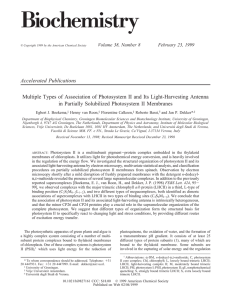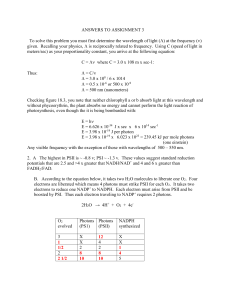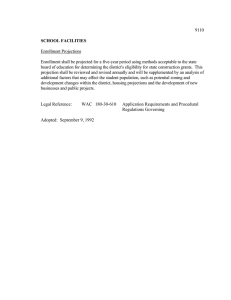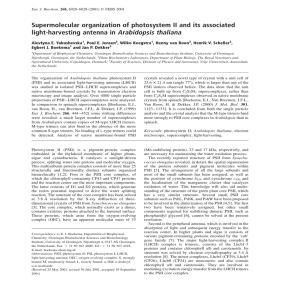Heptameric association of light-harvesting complex II trimers in partially
advertisement
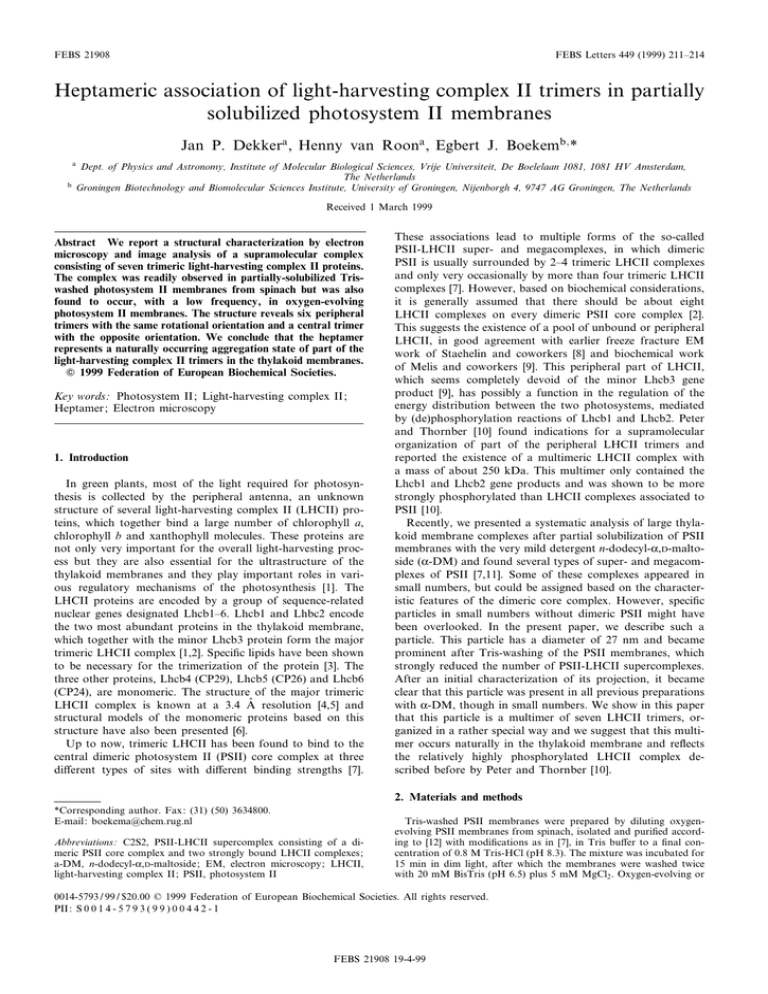
FEBS 21908 FEBS Letters 449 (1999) 211^214 Heptameric association of light-harvesting complex II trimers in partially solubilized photosystem II membranes Jan P. Dekkera , Henny van Roona , Egbert J. Boekemb; * a b Dept. of Physics and Astronomy, Institute of Molecular Biological Sciences, Vrije Universiteit, De Boelelaan 1081, 1081 HV Amsterdam, The Netherlands Groningen Biotechnology and Biomolecular Sciences Institute, University of Groningen, Nijenborgh 4, 9747 AG Groningen, The Netherlands Received 1 March 1999 Abstract We report a structural characterization by electron microscopy and image analysis of a supramolecular complex consisting of seven trimeric light-harvesting complex II proteins. The complex was readily observed in partially-solubilized Triswashed photosystem II membranes from spinach but was also found to occur, with a low frequency, in oxygen-evolving photosystem II membranes. The structure reveals six peripheral trimers with the same rotational orientation and a central trimer with the opposite orientation. We conclude that the heptamer represents a naturally occurring aggregation state of part of the light-harvesting complex II trimers in the thylakoid membranes. z 1999 Federation of European Biochemical Societies. Key words: Photosystem II; Light-harvesting complex II; Heptamer; Electron microscopy 1. Introduction In green plants, most of the light required for photosynthesis is collected by the peripheral antenna, an unknown structure of several light-harvesting complex II (LHCII) proteins, which together bind a large number of chlorophyll a, chlorophyll b and xanthophyll molecules. These proteins are not only very important for the overall light-harvesting process but they are also essential for the ultrastructure of the thylakoid membranes and they play important roles in various regulatory mechanisms of the photosynthesis [1]. The LHCII proteins are encoded by a group of sequence-related nuclear genes designated Lhcb1^6. Lhcb1 and Lhbc2 encode the two most abundant proteins in the thylakoid membrane, which together with the minor Lhcb3 protein form the major trimeric LHCII complex [1,2]. Speci¢c lipids have been shown to be necessary for the trimerization of the protein [3]. The three other proteins, Lhcb4 (CP29), Lhcb5 (CP26) and Lhcb6 (CP24), are monomeric. The structure of the major trimeric î resolution [4,5] and LHCII complex is known at a 3.4 A structural models of the monomeric proteins based on this structure have also been presented [6]. Up to now, trimeric LHCII has been found to bind to the central dimeric photosystem II (PSII) core complex at three di¡erent types of sites with di¡erent binding strengths [7]. These associations lead to multiple forms of the so-called PSII-LHCII super- and megacomplexes, in which dimeric PSII is usually surrounded by 2^4 trimeric LHCII complexes and only very occasionally by more than four trimeric LHCII complexes [7]. However, based on biochemical considerations, it is generally assumed that there should be about eight LHCII complexes on every dimeric PSII core complex [2]. This suggests the existence of a pool of unbound or peripheral LHCII, in good agreement with earlier freeze fracture EM work of Staehelin and coworkers [8] and biochemical work of Melis and coworkers [9]. This peripheral part of LHCII, which seems completely devoid of the minor Lhcb3 gene product [9], has possibly a function in the regulation of the energy distribution between the two photosystems, mediated by (de)phosphorylation reactions of Lhcb1 and Lhcb2. Peter and Thornber [10] found indications for a supramolecular organization of part of the peripheral LHCII trimers and reported the existence of a multimeric LHCII complex with a mass of about 250 kDa. This multimer only contained the Lhcb1 and Lhcb2 gene products and was shown to be more strongly phosphorylated than LHCII complexes associated to PSII [10]. Recently, we presented a systematic analysis of large thylakoid membrane complexes after partial solubilization of PSII membranes with the very mild detergent n-dodecyl-K,D-maltoside (K-DM) and found several types of super- and megacomplexes of PSII [7,11]. Some of these complexes appeared in small numbers, but could be assigned based on the characteristic features of the dimeric core complex. However, speci¢c particles in small numbers without dimeric PSII might have been overlooked. In the present paper, we describe such a particle. This particle has a diameter of 27 nm and became prominent after Tris-washing of the PSII membranes, which strongly reduced the number of PSII-LHCII supercomplexes. After an initial characterization of its projection, it became clear that this particle was present in all previous preparations with K-DM, though in small numbers. We show in this paper that this particle is a multimer of seven LHCII trimers, organized in a rather special way and we suggest that this multimer occurs naturally in the thylakoid membrane and re£ects the relatively highly phosphorylated LHCII complex described before by Peter and Thornber [10]. 2. Materials and methods *Corresponding author. Fax: (31) (50) 3634800. E-mail: boekema@chem.rug.nl Abbreviations: C2S2, PSII-LHCII supercomplex consisting of a dimeric PSII core complex and two strongly bound LHCII complexes; a-DM, n-dodecyl-K,D-maltoside; EM, electron microscopy; LHCII, light-harvesting complex II; PSII, photosystem II Tris-washed PSII membranes were prepared by diluting oxygenevolving PSII membranes from spinach, isolated and puri¢ed according to [12] with modi¢cations as in [7], in Tris bu¡er to a ¢nal concentration of 0.8 M Tris-HCl (pH 8.3). The mixture was incubated for 15 min in dim light, after which the membranes were washed twice with 20 mM BisTris (pH 6.5) plus 5 mM MgCl2 . Oxygen-evolving or 0014-5793 / 99 / $20.00 ß 1999 Federation of European Biochemical Societies. All rights reserved. PII: S 0 0 1 4 - 5 7 9 3 ( 9 9 ) 0 0 4 4 2 - 1 FEBS 21908 19-4-99 212 J.P. Dekker et al./FEBS Letters 449 (1999) 211^214 Fig. 1. A gallery of projections of LHCII multimers selected from stained EM images. The last two projections (lowest row, in the middle) have additional protein and/or lipid attached, but their 3-fold averaged image (right) shows that they belong to the same type of complex. Tris-washed PSII membranes from spinach were partially solubilized with K-DM, subjected to gel ¢ltration chromatography and immediately prepared for electron microscopy (EM)as described before [7]. Transmission EM was performed with a Philips CM10 electron microscope at 52 000U magni¢cation. Negatively stained specimens were prepared on glow-discharged carbon-coated copper grids as in [7]. Micrographs were digitized with a Kodak Eikonix Model 1412 CCD camera with a step size of 25 Wm, corresponding to a pixel size of 0.485 nm at the specimen level. Projections were extracted for image analysis with IMAGIC software [13] following alignment procedures and treatment by multivariate statistical analysis and classi¢cation as described previously [7,13,14]. 3. Results Inspection of EM images of chromatography-puri¢ed, Triswashed, K-DM-solubilized PSII membranes revealed the presence of three di¡erent types of projections (not shown). The ¢rst type was the most abundant and could easily be attributed to dimeric PSII core complexes, which due to the Triswashing lost the extrinsic proteins and the capability to oxidize water. Oxygen-evolving PSII core complexes have been structurally characterized in several earlier publications (see, e.g. [14]). The second type was less abundant and could be attributed to PSII-LHCII supercomplexes [7,14]. Both types of projections show some new features in the PSII parts, which presumably are caused by the Tris-washing and which will be described in detail elsewhere. The third type of projection was about as abundant as the second type, was not observed before and forms the subject of this paper. Further inspection of this third type of projections reveals a more or less circular particle with a diameter of 27 nm, a relatively faint staining halo around the particles and lowcontrast inner features (see Fig. 1 for a gallery of projections), indicating that it should be a rather £at membrane protein complex. After selecting about 100 projections from 35 digitized images and an initial image analysis, an average projection was used as a reference to screen previous datasets, obtained from oxygen-evolving, K-DM-solubilized PSII membranes [7,11], for similar looking particles. This yielded another 100 projections among the about 15 000 projections and indicated that the new particle was also present in oxy- Fig. 2. Final sum of 133 projections from a set of 197 aligned and classi¢ed projections of the LHCII multimer without symmetry imposed (A) and with three-fold symmetry imposed (B). The space bar equals 10 nm. FEBS 21908 19-4-99 J.P. Dekker et al./FEBS Letters 449 (1999) 211^214 213 gen-evolving material, though in lower numbers than in Triswashed material. For the set of 3300 projections obtained in [11], all projections with a size similar or larger than a C2 S2 PSII supercomplex were selected and by rechecking this dataset, it appeared that about 1% of the dataset could be attributed to the new particle. In Tris-washed material, this number is increased to about 7%. In a ¢nal analysis, 197 projections were repeatedly aligned and classi¢ed (not shown), ¢rst without imposing symmetry (Fig. 2A). After it became apparent that the particles had a strong 3-fold symmetry, this symmetry was imposed on the ¢nal reference used for alignment and in the ¢nal sum of the best 133 projections (Fig. 2B). Tests showed that this sum is probably not much `contaminated' by projections with the wrong type of handedness, in line with our results on the PSII-LHCII supercomplexes [7], in which case the handedness was, however, much easier to establish. Although the dataset was partly collected by semi-automatic searching with a reference image and because high-correlation values sometimes do not coincide with the noise-covered signal of the individual projections, the entire dataset was found to be rather homogeneous. Only very few projections appeared to di¡er substantially from the average image. Two of those projections are shown in Fig. 1 (lowest row). These particles are larger on one side by the attachment of additional protein and/or lipid mass. Most of the projections that did not appear in the ¢nal sum were rather fuzzy. The ¢nal projection (Fig. 3) shows that the densities within the particle are grouped in such a way that a central triangle is surrounded by six outer triangles. The central triangle appears to be stronger stain-embedded. Comparison with the low-resolution projection map of trimeric LHCII obtained from stained two-dimensional crystals [15] shows a very close similarity, leaving no other possibility for our 27 nm particle than a con¢guration of seven LHCII trimers. Characteristic features, such as the stain-excluding tripod in the center and Fig. 3. The ¢nal sum of the 133 projections in Fig. 2B from which the low-frequency components (2.5 nm and larger) have been suppressed. The positions of the tripods in the seven trimers is indicated. The numbers re£ect the nine peripheral densities observed in the lower left and right trimers. nine densities in the periphery, are evident in both our projection (Fig. 3) and the crystal map [15]. 4. Discussion In this paper, we describe a ¢rst structural characterization of a supramolecular complex consisting of seven LHCII trimers. From the fact that this particle also appears (with a frequency of about 1%) in the complete mixture of K-DMsolubilized oxygen-evolving PSII membranes [11], we conclude that this icosienamer (from the Greek word icosiene for 21) represents a native association of LHCII in the thylakoid membranes. Arti¢cial aggregation is unlikely, in particular in the dataset obtained in [11], because in this case, a lowconcentration solubilization with small amounts of detergent was used, high-salt treatments were avoided and the total time of exposure to the detergent was less than 5 min. The estimated protein mass of the LHCII icosienamer is about 7U80 = 560 kDa. This is larger than the value of 250 kDa reported by Peter and Thornber [10] for their LHCII aggregate. However, the latter value is very likely an underestimation, because in the same paper [10], the dimeric PSII core complex and the C2 S2 PSII-LHCII supercomplex were estimated to be 230 and 350 kDa, respectively, while we know now that these complexes have masses of about 500 and 750 kDa, respectively [14]. Comparison of these numbers suggests that the LHCII multimer observed by Peter and Thornber [10] could easily have a mass slightly larger than the 500 kDa of the dimeric PSII core, in excellent agreement with the expected mass of the icosienamer. The total number of chlorophylls per icosienamer is 252 if one assumes that each LHCII monomer binds 12 Chl molecules [4]. The total number could increase to 294 if each LHCII monomer binds two additional Chl molecules that do not show in the crystal structure [4]. Our results indicate that the association of seven LHCII trimers represents a preferential association. Particles missing the central trimer or one of the peripheral trimers and particles with one additional trimer have not been observed, while particles with a few extra LHCII trimers did occur but in very low numbers (Fig. 1). A precise assignment of the densities observed in our images is somewhat speculative. A crystallographic analysis from Ku«hlbrandt [15] showed a rather low correlation between the projection maps from negatively stained and unstained crystals. But regardless of this exact assignment, the relative orientation of the trimers seems clear. All six outer trimers have the same (tests: within ¢ve degrees) parallel orientation that can only di¡er by increments of 120 degrees as a consequence of the 3-fold symmetry within each trimer (Fig. 3). The central trimer, however, is in an antiparallel orientation, because it di¡ers by 180 degrees. All adjacent trimers, including the central trimer, have center to center distances of about 8.2 nm. The organization of trimers within the icosienamer can probably not be considered as a nucleus of an arrangement of trimers in a crystalline hexagonal packing. The two-dimensional crystals analyzed by Ku«hlbrandt [15] do reveal a hexagonal packing, but in this case the central trimer is missing, the center to center distance is shorter (7.2 nm) and the neighboring trimers have opposite (£ip/£op) orientations. A hexagonal packing of six outer trimers and a seventh (non-crystallographic) trimer in the middle has been observed for the membrane bound protein annexin [16]. In this packing, how- FEBS 21908 19-4-99 214 J.P. Dekker et al./FEBS Letters 449 (1999) 211^214 ever, the outer trimers have p6 symmetry and make angles of 60 degrees, which is clearly not the case in our icosienamer. The rather low numbers in which the icosienamer appears and the large amounts of single LHCII trimers during the isolation procedures suggest that not all trimeric LHCII in the stacked thylakoid membrane is either bound to PSII or within a heptamer. Although it is probably too early to speculate on the function of the icosienamer, we would like to mention a possible role as a nucleus in the (de)stacking processes of the thylakoid membrane, a possible role in the energy redistribution as a result of (de)phosphorylation reactions and a possible role in the quenching of excess excitation energy. It has, for instance, been shown that LHCII aggregation causes a decrease of the £uorescence quantum yield and it has been suggested that this feature of LHCII could form the basis of the mechanisms by which an excess excitation energy is dissipated as heat in PSII [17]. For a further characterization of the structure and function, the puri¢cation of the icosienamer is an obvious next step. This would not only enable to resolve more structural details by analyzing a larger dataset and by using cryo-EM, it would also enable to study the spectroscopic properties and the biochemical details (such as the putative absence of Lhcb3, as in the complexes observed by Peter and Thornber [10]). Study of the icosienamer as a natural intermediate between the wellcharacterized LHCII trimers and the `small' LHCII aggregates with highly reduced light scattering [18], could certainly shed more light on the regulatory mechanisms that operate in PSII. References [1] Bassi, R., Sandona©, D. and Croce, R. (1997) Physiol. Plant 100, 769^779. [2] Jansson, S. (1994) Biochim. Biophys. Acta 1184, 1^19. [3] Hobe, S., Prytulla, S., Ku«hlbrandt, W. and Paulsen, H. (1994) EMBO J. 13, 3423^3429. [4] Ku«hlbrandt, W., Wang, D.N. and Fujiyoshi, Y. (1994) Nature 367, 614^621. [5] Ku«hlbrandt, W. (1994) Curr. Opin. Struct. Biol. 4, 519^528. [6] Sandona©, D., Croce, R., Pagano, A., Crimi, M. and Bassi, R. (1998) Biochim. Biophys. Acta 1365, 207^214. [7] Boekema, E.J., van Roon, H., Calkoen, F., Bassi, R. and Dekker, J.P. (1999) Biochemistry 38, 2233^2239. [8] Staehelin, L.A. (1983) J. Cell Biol. 97, 1327^1337. [9] Morissey, P.J., Glick, R.E. and Melis, A. (1989) Plant Cell Physiol. 30, 335^344. [10] Peter, G.F. and Thornber, J.P. (1991) J. Biol. Chem. 266, 16745^ 16754. [11] Boekema, E.J., van Roon, H. and Dekker, J.P. (1998) FEBS Lett. 424, 95^99. [12] Berthold, D.A., Babcock, G.T. and Yocum, C.F. (1981) FEBS Lett. 134, 231^234. [13] Harauz, G., Boekema, E. and van Heel, M. (1988) Methods Enzymol. 164, 35^49. [14] Boekema, E.J., Hankamer, B., Bald, D., Kruip, J., Nield, J., Boonstra, A.F., Barber, J. and Ro«gner, M. (1995) Proc. Natl. Acad. Sci. USA 92, 175^179. [15] Ku«hlbrandt, W. (1988) J. Mol. Biol. 202, 849^864. [16] Brisson, A., Bergsma-Schutter, W., Oling, F., Lambert, O. and Reviakine, I. (1999) J. Crystal Growth 196, 456^470. [17] Horton, P., Ruban, A.V. and Walters, R.G. (1996) Annu. Rev. Plant Physiol. Plant Mol. Biol. 47, 655^684. [18] Ruban, A.V., Calkoen, F., Kwa, S.L.S., van Grondelle, R., Horton, P. and Dekker, J.P. (1997) Biochim. Biophys. Acta 1321, 61^ 70. Acknowledgements: We thank Dr W. Keegstra for his help with image processing, Mr J.F.L. van Breemen for the technical assistance and Drs A. Brisson, R. Bassi, A.V. Ruban and H. van Amerongen for discussions. FEBS 21908 19-4-99

